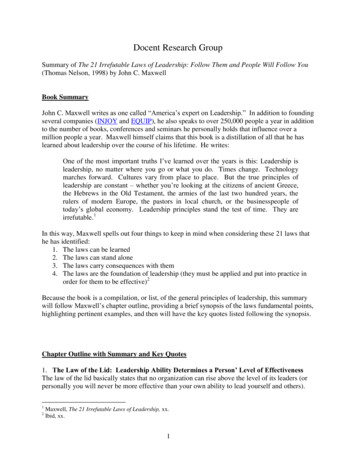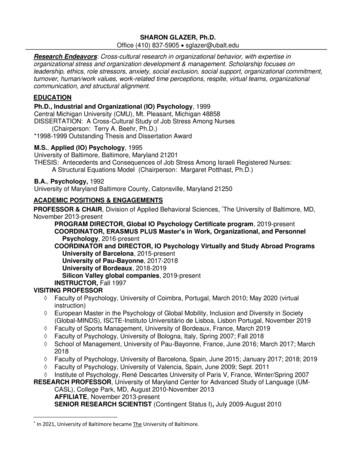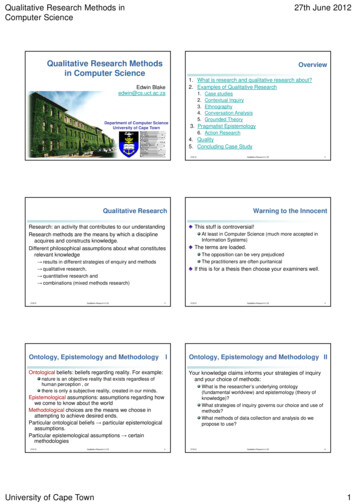
Transcription
Docent Research GroupSummary of The 21 Irrefutable Laws of Leadership: Follow Them and People Will Follow You(Thomas Nelson, 1998) by John C. MaxwellBook SummaryJohn C. Maxwell writes as one called “America’s expert on Leadership.” In addition to foundingseveral companies (INJOY and EQUIP), he also speaks to over 250,000 people a year in additionto the number of books, conferences and seminars he personally holds that influence over amillion people a year. Maxwell himself claims that this book is a distillation of all that he haslearned about leadership over the course of his lifetime. He writes:One of the most important truths I’ve learned over the years is this: Leadership isleadership, no matter where you go or what you do. Times change. Technologymarches forward. Cultures vary from place to place. But the true principles ofleadership are constant – whether you’re looking at the citizens of ancient Greece,the Hebrews in the Old Testament, the armies of the last two hundred years, therulers of modern Europe, the pastors in local church, or the businesspeople oftoday’s global economy. Leadership principles stand the test of time. They areirrefutable.1In this way, Maxwell spells out four things to keep in mind when considering these 21 laws thathe has identified:1. The laws can be learned2. The laws can stand alone3. The laws carry consequences with them4. The laws are the foundation of leadership (they must be applied and put into practice inorder for them to be effective)2Because the book is a compilation, or list, of the general principles of leadership, this summarywill follow Maxwell’s chapter outline, providing a brief synopsis of the laws fundamental points,highlighting pertinent examples, and then will have the key quotes listed following the synopsis.Chapter Outline with Summary and Key Quotes1. The Law of the Lid: Leadership Ability Determines a Person’ Level of EffectivenessThe law of the lid basically states that no organization can rise above the level of its leaders (orpersonally you will never be more effective than your own ability to lead yourself and others).12Maxwell, The 21 Irrefutable Laws of Leadership, xx.Ibid, xx.1
He cites two key examples: one from the business world, and the other from sports. For theleadership lid in sports Maxwell points to Norte Dame’s hiring Gerry Faust. The schoolsprevious success in football was a .759 winning percentage. In the early 80’s they hired GerryFaust who boasted an impressive high school winning record of 174-17-2. But upon beginninghis career at Norte Dame, his record was 30-26-1, with a .535 winning percentage, the thirdworst in Norte Dame’s history.Perhaps is more convincing anecdote comes from the history of McDonald’s. Whereas twobrothers originally founded the restaurant chain, Maurice and Dick McDonald in a suburb ofL.A., it wasn’t until the leader, Ray Kroc came in and took the small little family restaurantto the next level. Though the two brothers had tried to franchise their business model, theywere only able to sell their idea to 15 buyers, 10 of whom actually opened up a restaurant.Kroc was able to sell 100 franchises in only 5 years time, and the next five years saw theMcDonald’s concept spread to over 500 stores. In fact, if it wouldn’t have been for Kroc, thevery name McDonald’s would not have been explicitly tied to the stores that the McDonald’sbrothers franchised out. Kroc’s lid was significantly higher than the McDonald brothers. “Leadership ability is the lid that determines a person's level of effectiveness. Thelower an individual's ability to lead, the lower the lid on his potential. The higher theleadership, the greater the effectiveness Your leadership ability-for better or forworse-always determines your effectiveness and the potential impact of yourorganization.” (1) “In the years that Dick and Maurice McDonald had attempted to franchise their foodservice system, they managed to sell the concept to just fifteen buyers, only ten ofwhom actually opened restaurants. And even in that small enterprise, their limitedleadership and vision were hindrances. For example, when their first franchisee, NeilFox of Phoenix, told the brothers that he wanted to call his restaurant McDonald's,Dick's response was, "What . . . for? McDonald's means nothing in Phoenix." On theother hand, the leadership lid in Ray Kroc's life was sky high. Between 1955 and1959, Kroc succeeded in opening 100restaurants. Four years after that, there were 500McDonald's. Today the company has opened more than 21,000 restaurants in nofewer than 100 countries! Leadership ability-or more specifically the lack ofleadership ability - was the lid on the McDonald brothers' effectiveness.” (5) “The higher you want to climb, the more you need leadership. The greater the impactyou want to make, the greater your influence needs to be. Whatever you willaccomplish is restricted by your ability to lead others.” (6) “Don [Stephenson, the chairman of Global Hospitality Resources, Inc., of San Diego,California, an international hospitality advisory and consulting firm] said thatwhenever they came into an organization to take it over, they always started by doingtwo things: First, they trained all the staff to improve their level of service to thecustomers; and second, they fired the leader. When he told me that, I was at firstsurprised. "You always fire him?" I asked. "Every time?" "That's right. Every time,"he said. "Don't you talk to the person first-to check him out to see if he's a goodleader?" I said. "No," he answered. "If he'd been a good leader, the organizationwouldn't be in the mess it's in." (10)2
2. The Law of Influence: The True Measure of Leadership is Influence – Nothing More,Nothing LessThe true nature of leadership is one’s ability to influence others to follow you in whateverenterprise you are taking. This is what is fundamental to anyone who aspires to leadership. It isnot management, entrepreneurial prowess, knowledge, pioneering spirit or experience nor is iteven position. If you have no ability to influence others, you will not be able to lead themwithout having some form of leverage over them – like salary, benefits, freedom of time or fromincarceration (in the realm of military personnel). Influence is the only capital that is effectivefor leadership in a volunteer based organization. “In a 1996 poll published by the London Daily Mail, Princess Diana and MotherTeresa were voted in first and second places as the world's Mother Teresa were votedin first and second places as the world's you have a lot of influence. How didsomeone like Diana come to be regarded in the same way as Mother Teresa? Theanswer is that she demonstrated the power of the Law of Influence.” (11) “In the beginning, Diana's title had merely given her a platform to address others, butshe soon became a person of influence in her own right. In 1996 when she wasdivorced from Prince Charles, she lost her title, but that loss didn't at all diminish herimpact on others. Instead, her influence continued to increase I while that of herformer husband and in-laws declined-despite their royal titles and position. Why?Diana instinctively understood the Law of Influence . Ironically, even in deathDiana continued to influence others. When her funeral was broadcast on televisionand BBC Radio, it was translated into forty-four languages. NBC estimated that thetotal audience numbered as many as 2.5 billion people-more than twice the number ofpeople who watched her wedding.” (13) “True leader ship cannot be awarded, appointed, or assigned. It comes only frominfluence, and that can't be mandated. It must be earned. The only thing a title canbuy is a little time-either to increase your level of influence with others or to erase it.”(14) “A widespread misunderstanding is that leading and managing are one and thesame . The main difference between the two is that leadership is about influencingpeople to follow, while management focuses on maintaining systems andprocesses .The best way to test whether a person can lead rather than just manage isto ask him to create positive change. Managers can maintain direction, but they can'tchange it. To move people in a new direction, you need influence.” (14) “[Ron] Popeil3 is certainly enterprising, innovative, and successful.But that doesn'tmake him a leader. People may be buy have earned. But that doesn't make him aleader. People may be buying what he has to sell, but they're not following him. Atbest, he is able to persuade people for a moment, but he holds no long-term influencewith them.” (15) “IQ doesn't necessarily equate to leadership.”(15) “To be a leader, a person has to not only be out front, but also have people leader, aperson has to not only be out front, but also have people his vision.” (16)3An American inventor and marketing personality, whose many products have been sold and who is largelyresponsible for the wide-spread phenomenon of direct sales. Link: http://en.wikipedia.org/wiki/Ron Popeil3
“Positional leadership doesn't work in volunteer organizations. Because a leaderdoesn't have leverage-or influence-he is ineffective. In other organizations, the personwho has position has incredible lever age. In the military, leaders can use rank and, ifall else fails, throw people into the brig. In business, bosses have tremendous leveragein the form of salary, benefits, and perks. Most followers are pretty cooperative whentheir livelihood is at stake . But in voluntary organizations, such as churches, theonly thing that works is leader hip in its purest form. Leaders have only theirinfluence to aid them.” (18)3. The Law of Process: Leadership Develops Daily, Not in a DayLeadership takes time to develop. It grows through the series of daily improvements and growthfrom where you were to where you are on the way to where you’re going. It follows through fourphases: I don’t know what I don’t know, I know what I don’t know, I grow and know and itstarts to show, and I simply go because of what I know (pp. 24-26) “Becoming a leader is a lot like investing successfully in the stock market. If yourhope is to make a fortune in a day, you're not going to be successful. What mattersmost is what you do day by day over the long haul.” (23) “ [L]eadership experts Warren Bennis and Burt Nanus made a discovery about therelationship between growth and leadership: "It is the capacity to develop andimprove their skills that distinguishes leaders from their followers.” Successfulleaders are learners. And the learning process is ongoing, a result of self-disciplineand perseverance. The goal each day must be to get a little better, to build on theprevious day's progress.” (23-24) “English Prime Minister Benjamin Disraeli wisely commented, "To be conscious thatyou are ignorant of the facts is a great step to knowledge." (25) “Benjamin Disraeli asserted, "The secret of success in life is for a man to be ready forhis time when it comes." What a person does on a disciplined, consistent basis getshim ready, no matter what the goal.” (27) “There is an old saying: Champions don't become champions in the ring-they aremerely recognized there.” (28)4. The Law of Navigation: Anyone Can Steer the Ship, But it Takes a Leader to Chart theCourseIt takes more than exerting control or even influence to be an effective leader; it takes seeingahead, further and before others see and then orchestrating a clear and thorough path/plan forreaching that destination. This is navigation. Navigator’s are characterized by four things: thedraw on past experience, listen to what other’s have to say, examine the conditions beforemaking commitments and make sure their conclusions represent both faith and fact (pp. 36-38).To better serve himself and other leaders, Maxwell employs the following acrostic to help himgrow in his navigator role (40): Predetermine a course of action. Lay out your goals. Adjust your priorities. Notify key personnel. Allow time for acceptance. Head into action.4
Expect Problems.Always point to the success.Daily review of your plan. “Followers need leaders able to effectively navigate for them. When they're facinglife and-death situations, the necessity is painfully obvious. But, even whenconsequences aren't as serious, the need is just as great. The truth is that nearlyanyone can steer the ship, but it takes a leader to chart the course.” (36)General Electric chairman Jack Welch asserts, "A good leader remains focused.Controlling your direction is better than being controlled by it." Welch is right, butleaders who navigate do even more than control the direction in which they and theirpeople travel. They see the whole trip in their minds before they leave the dock. ·They have a vision for their destination, they understand what it will take to get there,they know who they'll need on the team to be successful, and they recognize theobstacles long before they appear on the horizon.” (36)Leroy Eims, author of Be the Leader You Were Meant to Be, writes, ''A leader is onewho sees more than others see, who sees farther than others see, and who sees beforeothers do." (36)“No matter how much you learn from the past, it will never tell you all you need toknow for the present. That's why top-notch navigators gather information from manysources. They get ideas from members of their leadership team. They talk to thepeople in their organization to find out what's happening on the grassroots level. Andthey spend time with leaders from outside the organization who can mentor them.”(38)“Major barriers to successful planning are fear of change, ignorance, uncertaintyabout the future, and lack of imagination.” (41)“When you prepare well, you convey confidence and trust to the people. I Lack ofpreparation has the opposite effect. You see, it's not the size of the project thatdetermines its acceptance, support, and success. It's the size of the leader.” (42)5. The Law of E.F. Hutton: When the Real Leader Speaks, People ListenMaxwell delineates once again that real leadership is not a position or authority, but influence.He provides a helpful grid for seeing the differences between the two styles:Positional LeadersReal LeadersSpeak firstNeed the influence of a real leader to GTDInfluence only the other positional leadersSpeak laterNeed only their own influence to GTDInfluence everyone in the roomOver the course of time, there are seven traits that emerge to develop a leader; they are: character(who you are), relationships (who you know), knowledge (what you know), intuition (what youfeel), experience (where you’ve been), past success (what you’ve done) and ability (what theycan do), (50-51). “You've probably heard of E. F. Hutton, the financial services company. Years ago,their motto was, "When E. F. Hutton speaks, people listen." (45)5
“It's similar to something former British Prime Minister Margaret Thatcher once said:"Being in power is like being a lady. If you have to tell people you are, you aren't."(4%)“ go to a meeting with a group of people you've never met before and watch themfor five minutes. You'll know who the leader is. When somebody asks a question,who do people watch? Who do they wait to hear? The person they look to is the realleader.” (47)“I read a story about former NBA player Larry Bird that illustrates it well. During thefinal seconds of an especially tense game, Boston Celtics coach K. C. Jones called atime-out. As he gathered the players together at courtside, he diagrammed a play,only to have Bird say, "Get the ball out to me and get everyone out of myway." Jones responded, "I'm the coach, and I'll call the plays!" Then he turned to theother players and said, "Get the ball to Larry and get out of his way." It just showsthat when the real leader speaks, people listen.” (49)6. The Law of Solid Ground: Trust is the Foundation of LeadershipTrust is not only a pre-requisite for leadership, but it is the fundamental building blocks of it.Once you forfeit trust among your followers, you have forfeited your ability to lead them. “Your people know when you make mistakes. The real question is whether you'regoing to less up. If you do, you can often quickly regain their trust.” (57) “Trust is the foundation of leadership. To build trust, a leader must exemplify thesequalities: competence, connection, and character. People will forgive occasionalmistakes based on ability, especially if they can see that you're still growing as aleader. But they won't trust someone who has slips in character.” (58) “Character makes trust possible. And trust makes leadership possible.” (58) “How do leaders earn respect? By making sound decisions, admitting their mistakes,and putting what's best for their followers and the organization ahead of their personalagendas.” (60-61)7. The Law of Respect: People Naturally Follow Leaders Stronger Than ThemselvesPeople will only follow those people who are stronger leaders than they are. With high caliberleadership (character & competency), you can initiate major change and sustain forwardmomentum in any organization. “People don't follow others by accident. They follow individuals whose leadershipthey respect In general followers are attracted to people who are better leadersthan themselves. That is the Law of Respect.” (70-71) “The greatest test of respect comes when a leader creates major change in anorganization.” (76)8. The Law of Intuition: Leaders Evaluate Everything with a Leadership BiasLeaders funnel everything through a grid of leadership intuition; there is something that they cansee that others can’t. How leaders think and respond is largely a matter of informed intuition,and this helps them read the intangible nature of leadership situations. In this way, leaders are:readers of their situation, trends, their resources, people, and themselves (pp. 82-84). Maxwellorganizes people’s leadership intuition into three categories: those who naturally see it, thosewho are nurtured to see it, and those who will never see it. (85)6
“All professional quarterbacks have physical talent. At the pro level the differences inphysical ability really aren't that significant. What makes one man a third-stringbackup and another a Hall of Famer is intuition. The great ones can see things otherscan't, make changes, and move forward before others know what's happening.” (78)“People need a goal to galvanize them.” (81)“What you see results from who you are.How you see the world around you isdetermined by who you are.” (84-85)“Leadership is really more art than science. The principles of leadership are constant,but the application changes with every leader and every situation. That's why itrequires intuition. Without it, you can get blindsided, and that's one of the worstthings that can happen to a leader. If you want to lead long, you've got to obey theLaw of Intuition.” (88)9. The Law of Magnetism: Who You are is Who You AttractYou may think that you are being stifled or hindered because of other people around you. Butthe truth is that you attract who you are. If you spend a lot of time wishing your people weredifferent in order to get different results, perhaps you need to think about how to make a changewith yourself. “Believe it or not, who you get is not determined by what you want. It's determinedby who you are.” (90) “Good leaders know that one secret to success is to staff their weaknesses. That waythey can focus and function in their areas of strength while others take care of theimportant matters that would otherwise be neglected. But it's crucial to recognize thatpeople who are different will not naturally be attracted to you. Leaders draw peoplewho are like themselves.” (92) “Whatever character you possess you will likely find in the people who follow you.”(95) “If you think the people you attract could be better, then it's time for you to improveyourself.” (97)10. The Law of Connection: Leaders Touch a Heart Before They Ask for a HandIts easier to just ask people to do something for you, but that does not result in a high level ofcommitment on their part. To truly lead others and your organization, you have to make apersonal and emotional connection with your people before you can have success in deliveringaction items needed to move the organization forward. “You can't move people to action unless you first move them with emotion. The heartcomes before the head.” (101) “A key to connecting with others is recognizing that even in a group, you have torelate to people as individuals. General Norman Schwarzkopf remarked, "I have seencompetent leaders who stood in front of a platoon and see it as 44 individuals, each ofwhom has aspirations, of a platoon and see it as 44 individuals, each of whom hasaspirations, each of whom wants to live, each of whom wants to do good." (103) “I've had the opportunity to speak to some wonderful audiences during the course ofmy career. The largest have been in stadiums where 60,000 to 70,000 people were inattendance. Some of my colleagues who also speak for a living have asked me, "Howin the world do you speak to that many people?" The secret is simple. I don't try to7
talk to the thousands. I focus on talking to one person. That's the only way to connectwith people.” (104)“It's the leader's job to initiate connection with the people.” (105)“It may sound corny, but it's really true: People don't care how much you know untilthey know how much you care.” (107)“There's an old saying: To lead yourself, use your head; to lead others, use yourheart Always touch a person's heart before you ask him for a hand.” (108)11. The Law of the Inner Circle: A Leaders’ Potential is Determined by Those Closest ToHimNo one is an island, and the people you surround yourself with will determine your ability tocause and effect change or improvement. The following are ways in which people can add valueto any organization and are worth surrounding yourself with for the sake of your organization;there are those who have potential value (those who raise themselves up), those who havepositive value (they raise morale in the organization), those who have personal value (those whoraise up the leader), those who have production value (they raise up others) and those withproven value (those who raise people who raise up other people). (115-16) “You see, every leader's potential is determined by the people closest to him. If thosepeople are strong, then the leader can make a huge impact. If they are weak, he can't.That is the Law of the Inner Circle.” (110) “It's lonely at the top, so you'd better take someone with you." (115) “Lee Iacocca says that success comes not from what you know, but from who youknow and how you present yourself to each of those people.” (119)12. The Law of Empowerment: Only Secure Leaders Give Power to OthersMaxwell gives several reasons why leaders choose not to empower others, and in so doing, stiflethe overall success of others and their organization. He lists a desire for job security, resistanceto change and lack of self-worth as the three main culprits (126-27). “But if you want to be successful as a leader, you have to be an empowerer. TheodoreRoosevelt realized that, "the best executive is the one who has sense enough to pickgood men to do what he wants done, and the self-restraint enough to keep frommeddling with them while they do it." (126) “A weak leader worries that if he helps subordinates, he will become dispensable. Butthe truth is that the only way to make yourself indispensable is to make yourselfdispensable. In other words, if you are able to continually empower others and helpthem develop so that they become capable of taking over your job, you will becomeso valuable to the organization that you become indispensable.” (126-27)13. The Law of Reproduction: It take a Leader to Raise Up a LeaderThe single most effective way to ensure success in any endeavor is to be the kind of leader thatothers will want to follow. You will maximize your organizational success by both being abetter leader and by intentionally developing other leaders around you. “But more than four out of five of all the leaders that you ever meet will haveemerged as leaders because of the impact made on them by established leaders whomentored them.” (134 – based on Maxwell’s surveys of leaders attending hisseminars/conferences over the years)8
“We teach what we know; we reproduce what we are.” (138)“If a company has poor leaders, what little leadership it has will only get worse. If acompany has strong leaders-and they are reproducing themselves-then the leadershipjust keeps getting better and better.” (140)14. The Law of Buy-In: People Buy Into the Leader, Then the VisionLeadership and vision are separate but necessary components to influencing a group of people.However what matters most to your followers is you – the leader – and then the vision. A tableillustrates this best (147):LEADERDon’t buy inDon’t buy inBuy inBuy in VISIONDon’t buy inBuy inDon’t buy inBuy in ResultGet another leaderGet another leaderGet another visionGer behind the leader“The leader finds the dream and then the people. The people find the leader, and thenthe dream.” (145)“You see, many people who approach the area of vision in leader- I ship have it allbackward. They believe that if the cause is good enough, people will automaticallybuy into it and follow. But that's not how leadership really works. People don't at firstfollow worthy causes. They follow worthy leaders who promote worthwhile causes.People buy into the leader first, then the leader's vision. Having an under standing ofthat changes your whole approach to leading people.” (145)“Every message that people receive is filtered through the messenger who deliversit.” (146)“As a leader, you don't earn any points for failing in a noble cause. You don't getcredit for being "right." Your success is measured by your ability to actually take thepeople where they need to go. But you can do that only if the people first buy intoyou as a leader.” (151)15. The Law of Victory: Leaders Find a Way for the Team to WinFor any leader, there are three components for victory that must be accounted for: unity ofvision, diversity of skills, and a leader dedicated to victory and raising the players to theirpotential (161-62). “Every leadership situation is different. Every crisis has its own challenges. But Ithink that victorious leaders share an inability to accept defeat. The alternative towinning seems totally unacceptable to them, so they figure out what must be done toachieve victory, and then they go after it with everything at their disposal.” (153) “When the pressure is on, great leaders are at their best. Whatever is inside themcomes to the surface.” (158) “Leaders who practice the Law of Victory believe that anything less than success isunacceptable. And they have no Plan B. That keeps them fighting.” (164)16. The Law of the Big Mo: Momentum is the Leader’s Best Friend9
Momentum is critical for any leadership enterprise. Maxwell highlights four things thatmomentum does: it makes leaders look better than they are, helps followers perform better thanthey are, makes it easier to steer a group/organization and it is the most powerful change agent,(172-73). “Just as every sailor knows that you can’t steer a ship that isn’t moving forward,strong leaders understand that to change direction, you first have to create forwardprogress – and that takes the Law of the Big Mo [mentum].” (165) Jaime Escalante teaching advanced math to Garfield High School students in EastL.A.; basis of the movie Stand and Deliver. Took years of small, tiny steps ofprogress before the program was built up at the school. “The school that was oncethe laughingstock of the district and that had almost lost its accreditation had becomeone of the top three inner-city schools in the entire nation! That’s the power of theLaw of the Big Mo.” (171) “Harry Truman once said, "If you can't stand the heat, get out of the kitchen." But forleaders, that statement should be changed to read, "If you can't make some heat, getout of the kitchen." (171)17. The Law of Priorities: Leaders Understand that Activity is Not NecessarilyAccomplishmentMaxwell recounts from personal experience and anecdotally the importance of not just doing alot of activity, but making sure that it's the right kind of activity. He says that what has helpedhim the most in this is living by two principles. The first being the Pareto Principle (80% of youreffectiveness is based on the best 20% of your effort/expenditure) and The Three R’s: what isrequired, what gives the greatest return, and what brings the greatest reward. (176-178) “Stephen Covey remarked, ‘A leader is the one who climbs the tallest tree, surveysthe entire situation, and yells, 'Wrong jungle!’'" (176) “We’re all accountable to somebody – an employer, a board of directors, outstockholders, or someone else. For that reason, your list of priorities must alwaysbegin with what is required of you. Anything required of you that’s not necessarilyfor you to do personally should be delegated or eliminated.” (177) “As a leader you should spend most of your time working in your areas of greateststrength. If something can be done 80 percent as well by someone else in yourorganization, delegate it. If a responsibility could potentially meet that standard, thendevelop a person to handle it.” (177) “ the greatest success comes only when you focus your people on what reallymatters.” (182)18. The Law of Sacrifice: A Leader Must Give Up to Go UpThe hallmark of leadership is not prestige or even power, but sacrifice. You have to give up yourrights and privileges in order to see your organization or endeavor succeed. “At least one sacrifice he made at that time received positive press: [Lee] Iacoccareduced his own salary to one dollar a year. At the time he said, ‘Le
Mar 21, 2016 · Summary of The 21 Irrefutable Laws of Leadership: Follow Them and People Will Follow You (Thomas Nelson, 1998) by John C. Maxwell Book Summary John C. Maxwell writes as one called “America’s expert on Leadership.” In addition to founding several companies (INJOY and EQUIP),











